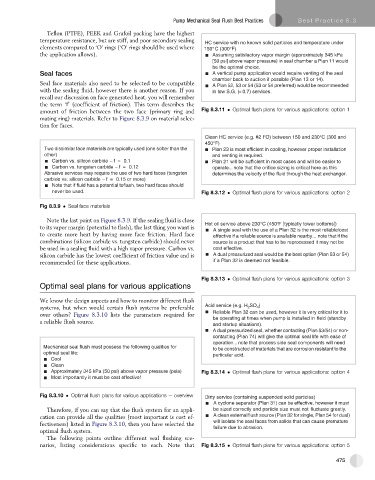Page 504 - Subyek Teknik Mesin - Forsthoffers Best Practice Handbook for Rotating Machinery by William E Forsthoffer
P. 504
Pump Mechanical Seal Flush Best Practices Be st Practice 8.3
Teflon (PTFE), PEEK and Grafoil packing have the highest
temperature resistance, but are stiff, and poor secondary sealing HC service with no known solid particles and temperature under
elements compared to ‘O’ rings (‘O’ rings should be used where 150°C (300°F)
the application allows). Assuming satisfactory vapor margin (approximately 345 kPa
[50 psi] above vapor pressure) in seal chamber a Plan 11 would
be the optimal choice.
Seal faces A vertical pump application would require venting of the seal
chamber back to suction if possible (Plan 13 or 14).
Seal face materials also need to be selected to be compatible A Plan 52, 53 or 54 (53 or 54 preferred) would be recommended
with the sealing fluid, however there is another reason. If you in low S.G. ( < 0.7) services.
recall our discussion on face generated heat, you will remember
the term ‘f’ (coefficient of friction). This term describes the
amount of friction between the two face (primary ring and Fig 8.3.11 Optimal flush plans for various applications: option 1
mating ring) materials. Refer to Figure 8.3.9 on material selec-
tion for faces.
Clean HC service (e.g. #2 FO) between 150 and 230°C (300 and
450°F)
Two dissimilar face materials are typically used (one softer than the Plan 23 is most ef fi cient in cooling, however proper installation
other) and venting is required.
Carbon vs. silicon carbide – f = 0.1 Plan 21 will be suf fi cient in most cases and will be easier to
Carbon vs. tungsten carbide – f = 0.12 operate ... note that the ori fi ce sizing is critical here as this
Abrasive services may require the use of two hard faces (tungsten determines the velocity of the fl uid through the heat exchanger.
carbide vs. silicon carbide – f = 0.15 or more)
Note that if fluid has a potential toflash, two hard faces should
never be used. Fig 8.3.12 Optimal flush plans for various applications: option 2
Fig 8.3.9 Seal face materials
Note the last point on Figure 8.3.9. If the sealing fluid is close
Hot oil service above 230°C (450°F [typically tower bottoms])
to its vapor margin (potential to flash), the last thing you want is
A single seal with the use of a Plan 32 is the most reliable/cost
to create more heat by having more face friction. Hard face effective if a reliable source is available nearby... note that if the
combinations (silicon carbide vs. tungsten carbide) should never source is a product that has to be reprocessed it may not be
be used in a sealing fluid with a high vapor pressure. Carbon vs. cost effective.
silicon carbide has the lowest coefficient of friction value and is A dual pressurized seal would be the best option (Plan 53 or 54)
recommended for these applications. if a Plan 32 is deemed not feasible.
Fig 8.3.13 Optimal flush plans for various applications: option 3
Optimal seal plans for various applications
We know the design aspects and how to monitor different flush
systems, but when would certain flush systems be preferable Acid service (e.g. H 2 SO 4 )
Reliable Plan 32 can be used, however it is very critical for it to
over others? Figure 8.3.10 lists the parameters required for
be operating at times when pump is installed in field (standby
a reliable flush source.
and startup situations).
A dual pressurized seal, whether contacting (Plan 53/54) or non-
contacting (Plan 74) will give the optimal seal life with ease of
operation... note that process side seal components will need
Mechanical seal fl ush must possess the following qualities for to be constructed of materials that are corrosion resistant to the
optimal seal life: particular acid.
Cool
Clean
Approximately 345 kPa (50 psi) above vapor pressure (psia) Fig 8.3.14 Optimal flush plans for various applications: option 4
Most importantly it must be cost effective!
Fig 8.3.10 Optimal flush plans for various applications e overview Dirty service (containing suspended solid particles)
A cyclone separator (Plan 31) can be effective, however it must
Therefore, if you can say that the flush system for an appli- be sized correctly and particle size must not fluctuate greatly.
cation can provide all the qualities (most important is cost ef- A clean externalflush source (Plan 32 for single, Plan 54 for dual)
fectiveness) listed in Figure 8.3.10, then you have selected the will isolate the seal faces from solids that can cause premature
failure due to abrasion.
optimal flush system.
The following points outline different seal flushing sce-
narios, listing considerations specific to each. Note that Fig 8.3.15 Optimal flush plans for various applications: option 5
475

